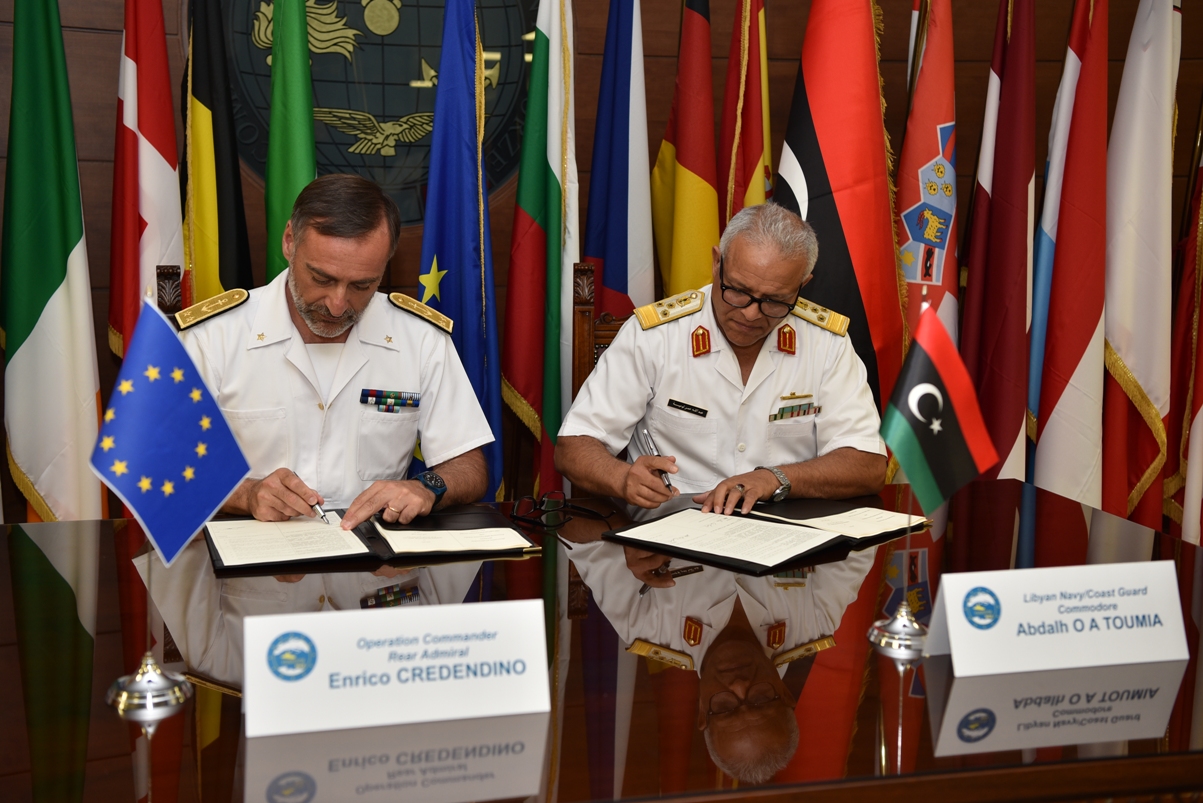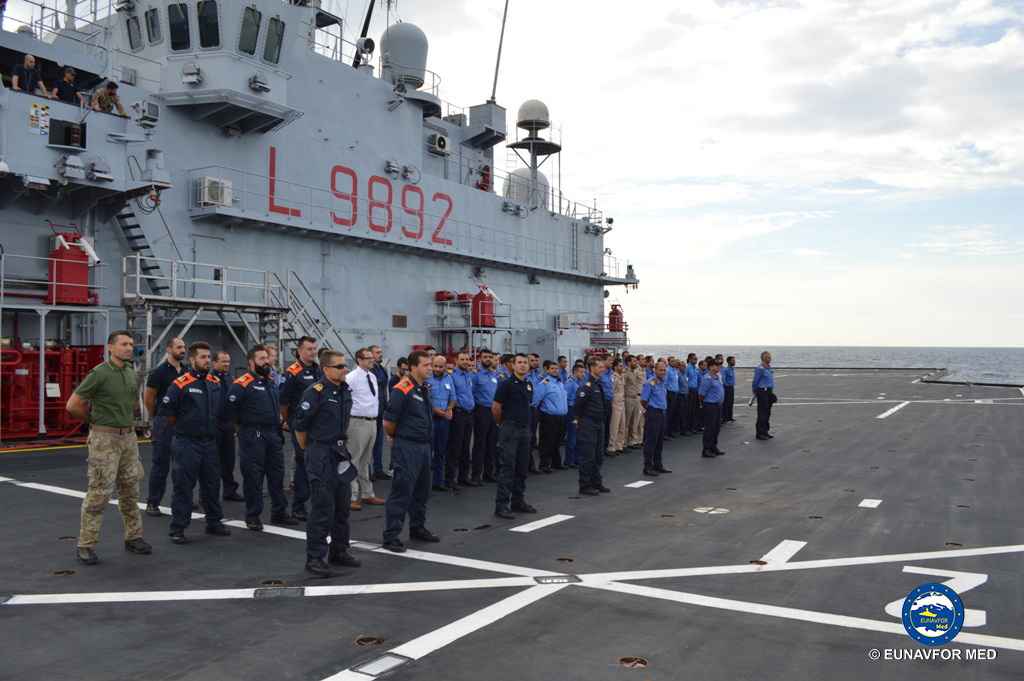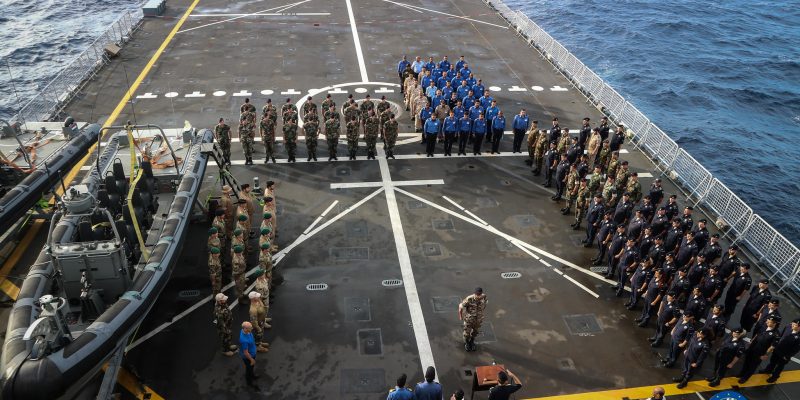A country that does not exist
The European Union wants to stop migrants coming from Africa, but it cannot do so alone. It needs Libya to control departures, and to carry out investigations into the main strongholds of human trafficking: a Libya with a Coast Guard and a Navy equipped to patrol the Mediterranean waters; a nation that will uphold bilateral agreements that involve the extradition of arrested smugglers (after the counter-piracy Operation Atlanta in Somalia where smugglers were turned over to third countries such as Kenya, Mauritius, and Seychelles). Both the EU and Italy want a peace agreement among the tribes of Fezzan, and a country with an efficient legal system that will neither violate human rights nor the right to asylum. In short, the Libya that Europe needs does not exist.
Nevertheless, the strategy of the European agency Frontex–exemplified by documents, analyses, and by the Africa-Frontex Intelligence Community Joint Report 2016–is merely to train military and police forces and to integrate the security and border control systems of various African countries. The stated goal is to limit migratory flows and to preserve the lives of migrants, but one is led to ask: do these strategies work?
The training of the Libyan Coast Guard
The decision to train the Libyans was made on June 20, 2016; the Memorandum of Understanding was signed August 23 by Admiral Enrico Credendino, commander in chief of the European fleet EUNAVFOR MED-Sophia, and the Commodore of the Libyan Coast Guard, Abdalh Toumia. Operations began October 27th: 93 officers and non-commissioned officers were trained for 14 weeks aboard two EUNAVFOR MED vessels with the help of two English teachers and eight interpreters. Training began aboard the Italian frigate San Giorgio and then the Dutch Rotterdam, continued in Gaeta with assistance from the Guardia di Finanza, and wrapped up on the islands of Crete and Malta. There were several delays as in September the port of Misurata, from which the Libyan trainees were scheduled to depart, was also the headquarters of the forces fighting to free the city of Sirte from ISIS. Furthermore, on one occasion the trainees defected in protest over unpaid salaries. One last delay occurred during the identity checks of the Libyan personnel: as Admiral Credendino explained before the Italian Senate, “the names were selected by cross-checking information from European information services: in five instances where doubts arose, the said personnel was not accepted for training.” In other words, the list of the 93 trainees was provided by Libya and then vetted by European intelligence services, as well as “the EUNAVFOR MED intelligence cell managed by a Finnish and a Spanish operation officer,” as cited by the admiral before the senate in February.
The training programme was divided into four-week modules, each followed by a 5-day break. Aboard the Rotterdam, training was provided by the Dutch, British, German, and Greek navies. Trainees were taught how to board and search ships, repair mechanical malfunctions, and put out fires. Training on board the San Giorgio covered the fundamentals of celestial navigations and chart work. The second phase saw Frontex and the Italian Coast Guard taking over with theory and practice lessons on international law, borders, and search and rescue activities. During the third module, the UN High Commissioner for Refugees provided training on human rights. Further activities included coastal and high sea navigation, telecommunications, first aid, maritime situational awareness, and the monitoring of fishing.

The signing of the agreement for the training of Libya’s Coast Guard (image: Ministero della Difesa/Marina Militare).
Who are the Libyan Coast Guard and Navy?
On May 10 an incident occurred off the coasts of Libya that could have had dire consequences. A Libyan Navy unit, the Kifah 206, interfered with Sea-Watch, an NGO trying to rescue 600 migrants adrift at sea. They did so with a dangerous manoeuvre, crossing the bow of the Sea-Watch ship at high speed and just narrowly avoiding a collision. It was a military-style manoeuvre conducted towards civilians. At that point, the Libyans brought the migrants from the wooden boat back to port without life vests, a dangerous operation that the Italians refuse to carry out. After the incident, one has to wonder: who are the Libyan Coast Guard? “There are at least two entities in Libya,” Eugenio Cusumano, assistant professor in International Relationships at the University of Leiden, explained. “A central military Navy and a Coast and Border Guard overseen by municipal authorities, which means the militias that control a certain areas.” The latter has few resources and is colluding with human traffickers in Tripolitania, as the press has revealed. The clans run the smuggling network using Mafia-style methods, and sometimes the military themselves are smugglers, as in the case of Abdurahman Al Milad, also known as Al-Bija, a Coast Guard commander in Zawiya and, according to several witnesses, a ringleader of smugglers.
This chaotic situation is compounded by the government’s ambiguity: Libya’s Foreign Minister Mohamed Salia explained how the PC/GNA, the UN-approved Government of National Accord, led by Fayez al-Serraj, has received requests from the international community to carry out military strikes against the migrant-smuggling militias. The government has denied these requests in order to “save any further Libyan bloodshed,” adding that Libya “would not be Europe’s policeman”, that Europe had to “accept its responsibilities. Libya must not defend Europe’s borders”, and that “There is no magic solution to the problem of illegal immigration.”
Furthermore, according to the NGOs working in the Mediterranean, there are not two, but at least three coast guards in Libya. Following incidents and gunfights, even spokespeople from Tripoli have talked of unidentified militias that are suspected of having seized uniforms, banners, and naval assets to patrol small stretches of sea. In the case of the May 10 incident, it is nearly impossible to understand who is speaking and which version is the most credible: on that same evening, Reuters interviewed Admiral Ayoub Amr Ghasem, the spokesman for the Libyan Coast Guard, who said that the incident occurred about 19 miles north of Libya’s coast (international waters, contiguous zone), and claimed that Sea-Watch had tried to hinder their work, not the other way around. The following morning, Ayoub Amr Ghasem confirmed this version of the events, this time not on behalf of the Coast Guard, but the Libyan Navy. Ghasem also spoke with AFP, claiming that the incident occurred “inside Libyan waters” (12 miles from the coast), contradicting his previous statement. A different version of the same events can be obtained from the video published on the website of Austria’s “Der Standard”. In the video, reporter Claas Meyer-Heuer says that, according to the Libyan commander, they were in “economic waters” while they were actually in the “exclusive economic zone”, also known as “continental platform”: a sea zone adjacent to territorial waters where the coastal state has sovereign rights only over the management and exploration of natural resources or research activities, but nothing more.

The start of training activities for the Libyan Navy on the San Giorgio and the Rotterdam (Image: Eunavfor Med).
And so, one also has to wonder: is this the Libyan Navy that the EUNAVFOR MED mission has been training? Is Libyan patrol vessel 206 one of the 10 rescue vessels being returned to Tripoli’s government? As early as 2009, Italy donated six patrol boats to Libya. Two were bombed and destroyed during the war, while the remaining four were anchored and repaired near Naples. The current plan is even more ambitious and will provide Libya with 10 ambulances, 24 dinghies, 30 jeeps, 15 cars, 30 Thuraya satellite phones, oxygen tanks, wetsuits, and night vision goggles. The total cost of 800 million euros will be covered by Brussels: 200 million have already been allocated and 600 more will be coming from the Fund for Africa. There are differences of opinion regarding the wisdom of providing the Libyans with military equipment: earlier in April, EU High Representative for Foreign Affairs and Security Policy Federica Mogherini said EUNAVFOR MED would provide “non-military assets to allow them to do their job in the territorial waters of Libya, so that the fight against smugglers can be more effective closer to the coast.” Commodore Abdalh Toumia, on the contrary, has since said that “these boats are not fitted with arms. We can’t use them for patrols. […] Before the revolution, we were dealing with unarmed traffickers. But now we are up against fierce, armed gangs.”
Libya: an unsafe country for diplomats but a safe haven for migrants?
On January 25, 2017, the delegation from the European Union Border Assistance Mission in Libya (EUBAM-Libya), which reports to the European External Action Service (the EU bureau of foreign diplomacy), wrote to Brussels: “Due to the absence of a functioning national Government [in Libya], genuine and legitimate state structures are difficult to identify […] The prohibitive security situation in Libya and limited access to Tripoli/Libya have not allowed the Mission to complete the collection of all necessary information to date.” EUBAM-Libya is the mission launched by the European Union on May 22, 2013, operating out of Tunis for security reasons, with a few brief missions in Tripoli. It was scheduled to last until August 21, 2016, with an annual budget of 17 million euros coming from the Athena Mechanism, the fund for EU military operations. Now that the Libyan Coast Guard and Navy have been trained and have been intercepting migrant boats, we are witnessing a paradoxical situation: Libya is not considered a safe country for EU officials, and as EUBAM wrote: “we expect that the majority of meetings with Libyans will still be conducted in Tunis until the security situation in Tripoli becomes more permissive.” And yet, at the same time, for migrants and refugees, Libya is a third country and a “safe haven” to which they can be pushed back, however indirectly. In the latest instance, on May 10, the push back even occurred with the tacit consent of Rome’s Maritime Rescue Coordination Centre. This had not happened a single time in the last three years.
We have been training the Libyans for 15 years and it hasn’t worked
The need to train and coordinate the Libyans is mentioned in Frontex documents from as early as 2004 when the European agency was less than a month old. An odd need, as there was no apparent “migrant boat emergency” at the time: the total number of arrivals that year was 13,635. The current training programme is therefore only the last piece of a puzzle that began 15 years ago. EUBAM-Libya itself has been operating under a dual political mandate: while it supports the PC/GNA in “state building” operations, offering logistical and administrative consultancy for the creation of judicial or legal systems, it has many other items on its agenda. The first of which is to develop an internal security apparatus against terrorism and the smuggling of weapons, goods, drugs, and especially oil (which is rampant along the Tunisian border near Ben Gardane). The second one is border control on land, sea, and air through an inter-ministerial task force called the Border Management Working Group, coordinating and training personnel from the navy, the police and the border guard, as well as the air force and customs officials in charge of passport checks and incoming goods control. Since 2013, theory and practice training has already taken place in several locations: Ghadames, Ra’s Ajdir, Tripoli, and Misurata.
The Chief of the EUBAM-Libya mission is Police Colonel Vincenzo Tagliaferri (1963). He speaks English, Arabic, and French and has held several posts as a liaison between Italy and Libya. He was head of the Interior Ministry Office at the Italian Embassy in Libya in 2013; a member of the Interior Ministry Department of Public Security, mainly dealing with MENA (Middle East and North Africa) countries; and one of 23 men in the Guardia di Finanza Libyan mission from May 2009 to March 2011. The task force was charged with setting up and coordinating an operations centre in Zuwarah for maritime border control. A similar initiative was launched with the signing of the Memorandum of Understanding of February 2, 2017: the installation of an MRCC that would allow Libyans to manage a search and rescue area, thus exonerating Eunavfor Med, Mare Sicuro, and Italian Coast Guard units from rescue operations.

The start of training activities for the Libyan Navy (Image: Eunavfor Med).
The 2009 mission was born out of the Implementing Protocols signed by then-Interior Minister Giuliano Amato, and the Treaty on Friendship, Partnership and Cooperation between Italy and Libya signed in 2008 by Berlusconi with then-Interior Minister Maroni and Libyan leader Muammar Gaddafi. The agreements were met with enthusiasm by Italy’s top politicians. Minister Amato said in December 2007, “It will now be possible to patrol the coasts with joint units. Thus we will eradicate smuggling, save human lives, and defeat criminal gangs.” A few months later, this sentiment was echoed by Interior Minister Roberto Maroni: “It’s a decisive step forward. We are expecting a significant drop in arrivals by Easter, and zero arrivals by the summer.” Nine years on, migrant influx has increased sixfold and the European Court of Human Rights has condemned Italy in the Hirsi case. Those policies have also failed to secure the cooperation of the Libyans with the Guardia di Finanza officers, to the point that the 23 Italians were not allowed to wear uniforms, but only blue suits.
The Libyans have confirmed their reluctance to give up sovereignty. In late April, Italy’s Interior Minister Marco Minniti summoned the delegates of the main Fezzan tribes to Rome for the signing of a peace agreement. (The Tebu, Tuareg, and Awlad Suleiman waged war among themselves from 2011 until 2015.) Just 48 hours after the signing, however, a statement by the National Tebu Assembly appeared in the Libyan press, saying “those Tebus who signed the Rome deal did not represent the Tebu community. They were from Qatrun […] while the clashes from 2011 to 2015 between the Tuareg and Tebu and between the Tebu and the Awlad Suleiman occurred in Obari, Sebha, and Murzuk.” Saying that it understood Italy’s need to control the growing tide of migrants coming from Libya, the NTA added that this did not give Rome the right to intervene in Libyan internal affairs or disregard the official channels where the Italian government could lend a hand.
The Italian government doubled down with a new summit between the Interior Ministers of Libya, Chad, and Niger. While the economic and political understanding envisaged by Article 19 of the 2008 treaty entailed “a strong and wide industrial partnership in the defence and military sectors” and “the creation of a land border control system to be developed by Italian companies in possession of the required technological expertise,” (such as Selex-Leonardo-Finmeccanica, which was allocated 300 million euros for a radar surveillance system along the 5,000-km southern border), the goal today is different. “For the Libyan tribes, it’s a peace deal on the damage caused by the conflicts. They believe, or hope, that someone in Europe will compensate them,” Mattia Toaldo of the European Council on Foreign Relations explained, “whereas the Italian government wants to create a border guard corps and have members of the tribes involved in the management of the detention centres that have been discussed in the last few hours.” According to Toaldo, Minniti’s strategy is dangerous because “it sets a precedent where it’s the Interior Ministry, and not the Foreign Ministry, that negotiates with quasi-governmental groups. And especially dangerous because the goals of peace-making and smuggling control are at odds with each other: each group will try to cut the smuggling routes of other clans, creating the conditions for further conflicts.”
Translation by Francesco Graziosi. Proofreading by Alexander Booth.
All images by EUNAVFOR MED-Operation Sophia (CC 0).









